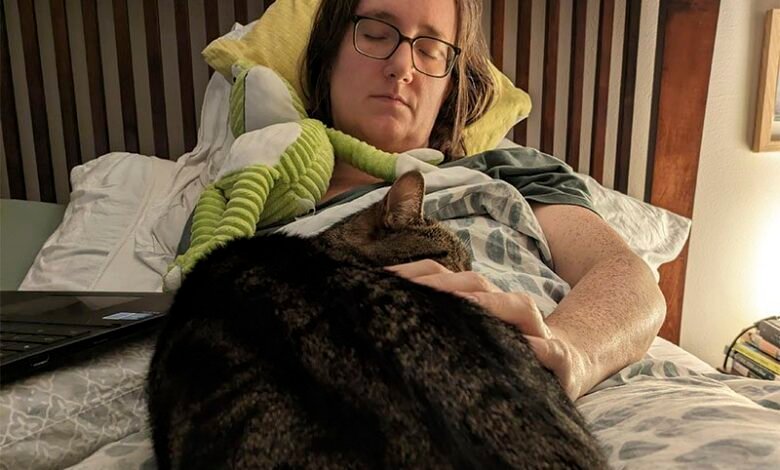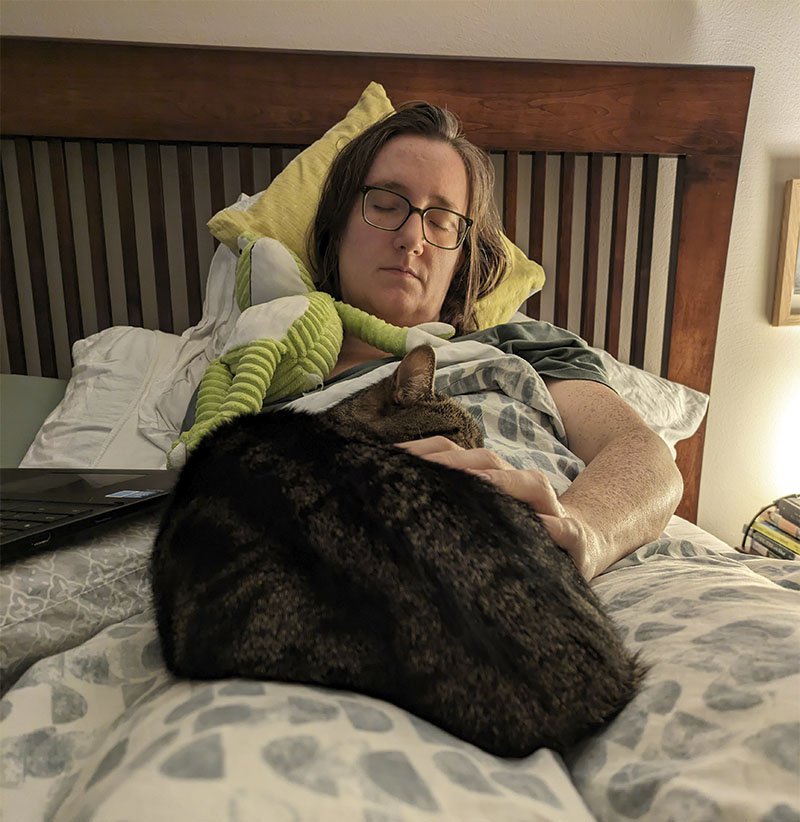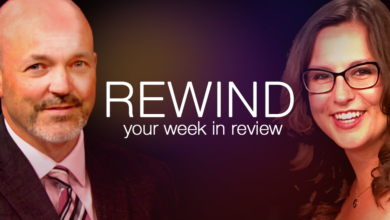The long arm of COVID – Isthmus


Fatigue, brain fog and other symptoms continue to plague more than 5% of Wisconsin residents
“It was like somebody flipped a switch,” Tim Gittings says, describing the onset of his long COVID symptoms. “I got nauseous and dizzy and disoriented. It felt like my batteries wouldn’t hold a charge.”
As a core company member at American Players Theatre in Spring Green, Gittings was accustomed to working long days and nights, rehearsing multiple shows at the same time, and leaping across the stage with a sword. But when these new symptoms appeared in June 2022 — more than two years after his first suspected COVID infection — his body could no longer keep up with the demands of the job.
“I would be in rehearsals and get a wave of [symptoms] and have to lie on the floor for a couple hours,” Gittings says. At one point, an EMT on staff thought he was having a heart attack.
Gittings had to drop out of shows and take less physically demanding roles, which APT was supportive of. But he says it was frustrating to work at a lower capacity than he was used to, especially when that meant putting pressure on other members of the company.
Physical therapist Autumn Bonner also struggled to keep up with her job responsibilities when her long COVID symptoms appeared. She experienced a mild case of COVID in July 2022, but when she returned to her private physical therapy clinic after a 10-day quarantine, she didn’t feel recovered. “I would work with a patient and then find myself more tired than normal. I was coming home at night, and the not-feeling-well would linger well through into the next day. I’d be exhausted and have headaches. That was the beginning of the long COVID.”
Gittings and Bonner are two of an estimated 247,000 Wisconsin adults currently experiencing long COVID, according to the latest available figures from the CDC — about 5% of the population. Of those people, about 73% experience activity limitations because of the disease. The most common symptoms include fatigue, brain fog, and post-exertional malaise, which refers to symptoms that get worse after even light activity. But experts have identified more than 200 symptoms.
Aurora Pop-Vicas is one of the few physicians in Madison who specializes in treatment for long COVID. As a UW Health infectious disease physician, she became interested in learning everything she could about the COVID virus during the pandemic. “We soon realized that it’s not quite the same as other upper respiratory viral pathogens. It’s very different. It doesn’t affect only the respiratory tract but, in fact, it can affect any of the organ systems in the body. It doesn’t necessarily end after the acute infection.”
For people struggling with such a diverse array of symptoms, getting a diagnosis can be difficult. Pop-Vicas calls long COVID a “diagnosis of exclusion.” There’s no test for it — instead, clinicians must rule out other underlying conditions.
Bonner, for example, struggled with symptoms for a year and a half without a diagnosis, during which time her private physical therapy practice suffered. “I wasn’t reliable in showing up for my patients, sometimes late canceling with an hour notice, due to becoming suddenly faint, or feverish, or having flank pain,” Bonner writes in a blog post. “In conversation with my administrative assistant or with a patient, I’d suddenly forget what I was saying and would have to pause for 10-20 seconds to collect myself. My hands would shake by the end of helping someone and I would try to hide the tremors.” When the long COVID diagnosis came, she realized she wasn’t going to get better. “The decision to close was probably one of the hardest decisions I’ve had to make,” she says.
The condition is much more than just a personal health struggle, Pop-Vicas stresses. “It takes out of the workforce millions of people every year,” she says. And though the Americans with Disability Act does consider long COVID a disability if it limits major life activities, the illness is so new that “proving” a long COVID disability can be difficult when applying for benefits.
Closing her practice took a huge financial toll on Bonner’s life. “Things had been basically going down in the dumps in terms of my earnings from July 2022 until December 2023,” she says. Though she made a personal disability insurance claim in December 2023, the insurance company denied it. “They did not have enough medical evidence, even though I had the long COVID diagnosis.” Bonner finally found a Meriter physical therapist who performed a disability evaluation, proving through objective measurements like heart rate and timed tests that Bonner was no longer able to perform her job responsibilities. Her claim was finally approved in June 2024. “We’d basically just been holding our breath and waiting to hear back from them,” Bonner says.
Because of long COVID’s huge, multi-faceted impact, addressing the crisis will require more than just further research. “The management of long COVID is in its infancy in Wisconsin and in Madison,” says Pop-Vicas. “This is a societal problem, not just a medical problem. Society should respond by providing community-based services that help with reducing some of these stressors, especially things that improve well being, like financial assistance.” She also notes the importance of partnering with community-based patient advocacy groups to make sure that Wisconsinites living with long COVID have input in the response.
For folks living with long COVID, life looks a lot different than it did before 2020. This spring, Gittings enrolled in the Post-COVID-19 Care Clinic at the Mayo Clinic in Rochester, Minnesota, where he’s learning to better manage his condition. “The big takeaway was that I have to stop pushing through things,” Gittings says. “You don’t necessarily recover with rest.” That’s been a hard adjustment to make for an actor who’s always lived by the philosophy of “the show must go on.”
Besides prioritizing rest, Bonner now dedicates herself to educating others, especially therapy healthcare providers, about long COVID. She maintains a blog about her experience and gives provider training sessions about how to screen for long COVID and initiate therapy-based treatment.
Both Bonner and Gittings say that they’re especially grateful to have supportive partners and peers during their long COVID journeys. Bonner’s message to people struggling with symptoms of long COVID is this: “Reach out for support from your friends, from your family, from your peers. It’s incredibly important to not go through it alone.”
Echoing this sentiment, Pop-Vicas says that one of the biggest issues she notices in her patients is loneliness. “For patients who are no longer able to keep up with their social interactions, with their work, with going out, they’re particularly lonely,” she says. “And they also feel as if sometimes their disease is not understood — that it’s dismissed or minimized by their community. They don’t look abnormal. There’s a tendency in people who are fine and going about their lives a hundred miles an hour to think: ‘Just snap out of it. What is wrong with you?’ And that approach just exacerbates the problem.”
Instead, she says that one of the most important things those without long COVID can do is to have empathy and understanding for people who are suffering. “That is the responsibility of the community — reach out and help when someone is in need.”



